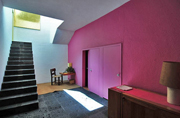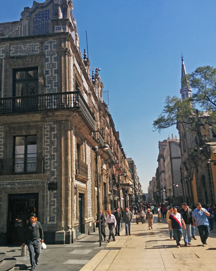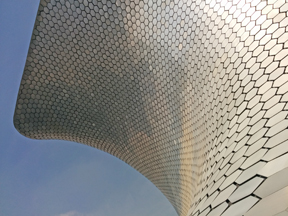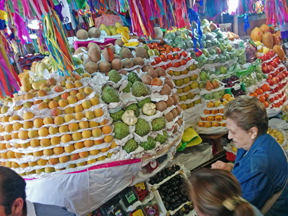Thanksgiving Getaway to Mexico City
 November in Mexico City may be the best time for both weather and air quality.....after the summer rains, the air is clear and smog-free, and the temperature delightfully fall-ish...mid 60's during the day. A four-hour flight south to Mexico City over Thanksgiving provides a needed holiday getaway combined with an easy way to avoid roast turkey.
November in Mexico City may be the best time for both weather and air quality.....after the summer rains, the air is clear and smog-free, and the temperature delightfully fall-ish...mid 60's during the day. A four-hour flight south to Mexico City over Thanksgiving provides a needed holiday getaway combined with an easy way to avoid roast turkey.
Evening traffic is however the same year-round, and the several mile ride from Benito Juarez to our hotel in the upscale area of Polanco takes almost an hour. Polanco sits just north of Chapultepec park, in which lie the zoo, botanical garden, museum of modern art, Museo Ruffino Tamayo, and the famous anthropological museum, most of which we'll see in the coming days.
Our lodging for five nights, Hotel Los Alcobas, was completely rebuilt from an apartment building on the upscale shopping street Presidente Masaryk several years ago by hotelier Samuel Leizorek, and is a lovely and refined boutique hotel. The small elegant lobby is filled with art, sculpture, a fountain and upsweep of a spiral staircase. Staff, concierge and manager couldn't be more helpful or friendly. Our reserved junior suite has been upgraded to the Suite Masaryk on the penthouse floor. Sort of C-shaped, the entry leads to the living room, with full glass walls leading onto a glass-railed terrace overlooking the wooded Polanco district. Wrapping around is a walk-in closet, bedroom, and finally enormous  bath...also peering onto the terrace. The walls are white-troweled stucco, accents and furnishings are in a patterned wood...perhaps rosewood, and red antheriums and white phalaenopsis orchids provide highlight color.
bath...also peering onto the terrace. The walls are white-troweled stucco, accents and furnishings are in a patterned wood...perhaps rosewood, and red antheriums and white phalaenopsis orchids provide highlight color.
Av. President Masaryk is THE upscale shopping street in Mexico City. Sidewalks are being replaced in textured granite blocks, succulents and leafy trees line the roadway median, and the spiderweb of utility wires are being undergrounded. This is one-stop Christmas shopping for the one percent (not us!)--Hermes, Cartier, Bulgari, Tiffany, Chopard, Tane, Zenga, Chanel, Louis Vuiton, and many of the top watch boutiques crowd into about five ritzy blocks.
This short four-day stay is meant as a cultural and gastronomic outing. The gastronomic component begins with dinner around the corner at Dulce Patria--a hot restaurant that features the inventive and nueva cucina Mexicana of Marta Ortiz. So inventive in fact that one hasn't a clue what a dish will bring based on its menu name: such as Maria goes to the Flower Shop, Vampire Ceviche, or the Fish Dances in Fire..... We stick with tarted-up classics, and are pleased with a very elegant black bean soup, esquites of corn, which combines both fresh and hominy kernels with a creamy sauce topped with cotija cheese, tiny multi colored quesadillas, and tacos of chilorio—a chile-spiced pulled pork originating in Sinaloa. Perhaps on our next visit we'll succumb to all of the menu flights of fancy.
 The next morning, after a very late Mexican breakfast, the culture component starts with a tour of the houses and studio of the famous Mexican architect Luis Barragan, located just south of Chapultapec park. As is often the case in Mexico, the house looks to be about absolutely nothing from the street side..grey stucco walls and complete anonymity.
The next morning, after a very late Mexican breakfast, the culture component starts with a tour of the houses and studio of the famous Mexican architect Luis Barragan, located just south of Chapultapec park. As is often the case in Mexico, the house looks to be about absolutely nothing from the street side..grey stucco walls and complete anonymity.
The two small entry rooms begin to lead one into the style of the house, introducing texture and Barragan's iconic colors of yellow, gold and shades of pink. The interior is a maze, or perhaps a rabbit warren...twists, turns, short walls beyond a doorway that entice with a glimpse of a soaring beamed ceiling, but which block the full view until you turn left, then right, to enter the large main living room and library. Large panes of floor-to-ceiling glass look onto the forest-like rear garden, and serve to visually bring the outdoors in. Barragan was reclusive and exceedingly religious. Many small spaces around the house provide place for meditative contemplation, in which he frequently indulged. All these meditative spaces are dominated by crucifixes, ranging from small to enormous. The exterior spaces—courtyards, the garden, the rooftop terrace exhibit the iconic Barragan look of large swaths of colorful, contrasting pink, ochre, yellow and gold made still bolder by the bright Mexican sun.
An afternoon window shopping stroll down Masaryk could be Rodeo Drive or Fifth Avenue with all the international luxury shops, save for a very few Mexican brands, the ubiquitous squad cars’ flashing lights, and hordes of hard-hatted hombres knocking off from the days labor on the streetscape...it would appear they're trying to finish the street renovation in time for Christmas. And it's one-percenter window shopping at its best. Oddly empty street, though--perhaps it's too early in the evening, but there is a notable lack of one-percenter shoppers.......
The five-block area just east and south of our hotel is ground zero for eating and dining in Polanco, with dozens of restaurants and bars. That evening we do a bit of a bar/snack crawl for dinner, with stops at Anatol, off the lobby of the hotel, then nearby Brassi, for margaritas and antojitos.
Wednesday morning we head to the Museo Mural Diego Rivera...located At the edge of Alameda park, which  contains only one mural, his "Dream of a Sunday in the Alameda "—but it's a huge and interesting piece, and captures the essence of his work. Notables from different periods of Mexican history are captured, and iconic points in that history depicted across the room-filling mural. Rivera depicts himself as a ten-year-old boy in front of his wife Frida Kahlo.
contains only one mural, his "Dream of a Sunday in the Alameda "—but it's a huge and interesting piece, and captures the essence of his work. Notables from different periods of Mexican history are captured, and iconic points in that history depicted across the room-filling mural. Rivera depicts himself as a ten-year-old boy in front of his wife Frida Kahlo.
 A ten-minute stroll across the Alameda brings one to the neoclassical Palacio de Bellas Artes, Mexico's most important cultural center and theater. From its plaza the pedestrian way Av. Francisco Madero leads to the Zocalo, or main square of Mexico City. Early on, Madero was one of the most desirable streets in the city on which to live or vend. These days, the quality of shops is fairly ordinary, but there are architectural gems worth note. On the left as you enter Madero is the Casa de Los Azuleos, an 18th century palace completely covered in blue tiles from Puebla (how does it withstand the quakes?). Nestled in a two story interior courtyard surrounded by muralled walls is the flagship of the Sanborns restaurant chain, where you can take a decent meal in pretty splendid surrounding, gazing at a colorful 1925 mural by Orozco called Omnisciencia.
A ten-minute stroll across the Alameda brings one to the neoclassical Palacio de Bellas Artes, Mexico's most important cultural center and theater. From its plaza the pedestrian way Av. Francisco Madero leads to the Zocalo, or main square of Mexico City. Early on, Madero was one of the most desirable streets in the city on which to live or vend. These days, the quality of shops is fairly ordinary, but there are architectural gems worth note. On the left as you enter Madero is the Casa de Los Azuleos, an 18th century palace completely covered in blue tiles from Puebla (how does it withstand the quakes?). Nestled in a two story interior courtyard surrounded by muralled walls is the flagship of the Sanborns restaurant chain, where you can take a decent meal in pretty splendid surrounding, gazing at a colorful 1925 mural by Orozco called Omnisciencia.
At number 17 sits the Palacio de Iturbide, completed in 1784 in the Italianate Baroque style. Now owned by Banamex, the enormous stone courtyard displays the bank's art collection, including portraits of grandees, early landscapes showing a sparsely populated Mexico valley, and more modern works by Orozco, Rivera, Tamayo and others.
The Zocalo itself, officially the Plaza de la Constitution is uninteresting...just a big open square....space for parades, displays, demonstrations. Six blocks south the Calle de Regina has been renovated--largely with funds from billionaire Carlos Slim--from a slum-cum parking lot, to a pedestrian way lined with bars, restaurants, outdoor cafés, galleries and shops. All two-story buildings, much of the ground floor architecture is hidden by the commerce, but gazing up to the line of second story facades, you see the historic center of the city much as it  was 400 years ago. At night this "cultural corridor"--so designated in 2007--comes alive with strollers and diners, street music, corner stand up comics, and revelry. At the west end of Regina you might even occasionally hear Gregorian chant faintly emanating from the thick walls of the Templo Regina Coelli.
was 400 years ago. At night this "cultural corridor"--so designated in 2007--comes alive with strollers and diners, street music, corner stand up comics, and revelry. At the west end of Regina you might even occasionally hear Gregorian chant faintly emanating from the thick walls of the Templo Regina Coelli.
Thanksgiving day turkey avoidance is accomplished at Biko—a refined space overlooking Av. Masaryk where basque chefs present both traditional and modern takes on their regional cuisine, overlayed with Mexican influence. The dining room is elegant and serene...taupe walls, white linen, blond wood.....color comes only on the plates. Interestingly there is almost no English spoken, and menu only in Spanish, so we're on our own pretty much to decipher. The traditional dishes are offered only in full portions, but the modern interpretations come in half portions, so we stick to that section of the menu. With cocktails the kitchen sends an ameuse of two small lamb sausages on a spicy yoghurt sauce accompanied by a shot of beet essence. I started with camarones con polvo de la cabesa--perfectly under-cooked shrimp served with a 'snow' of the pulverized shrimp-heads. Ternera estofada brings falling-off-the-bone short rib meat formed into small logs wrapped in caul fat, and sauced with an intense, dark reduction sauce. A delicious dish, but seemingly without much basque or Mexican influence. Chuletillas de Cordero are perfectly pink, charred-outside tiny lamb chops served simply with potato slices and shreds of pepper. Several terrific Spanish wines are served by the glass to accommodate diners who wish to taste around, and all four reds and whites we tried were terrific. An ice cream made of Idiazabal was both slightly sweet, and tangy with the blue cheese flavor--a most interesting combination. Service was friendly and efficient, and while the Basque-ness was not very evident in what we chose, the experience overall was quite good.
The next morning, on our way to see Carlos Slim's Museo Soumeya, we wander some of the side residential streets of Polanco. These lovely neighborhood blocks are tree-lined with upscale apartments, elegant older houses, cutting edge modern architecture, and the occasional concertina-wire topped high walls indicating a real desire for privacy and solitude. The whole area seems to be about 10 blocks by 20 blocks with our hotel on Av. Masaryk pretty much dead center. The many cruising police cars attest to the residents' desire to be fairly crime free, and their clout to achieve such protection.
 Museo Soumaya is a torquing, twisting roughly squat shot-glass, or vaguely mushroom-shaped windowless and highly reflective structure. Clad in thousands of hexagonal panels of aluminum, Soumaya was designed by Mexican architect Fernando Romero, who is the son in law of Carlos Slim. Romero was quoted in the New York Times in 2014 as saying that the museum "is designed to reflect organic forms growing out of the earth." It takes on a bit different aura from different viewing angles, as it plays with, and reflects other surrounding high rises, as well as the sky and clouds.
Museo Soumaya is a torquing, twisting roughly squat shot-glass, or vaguely mushroom-shaped windowless and highly reflective structure. Clad in thousands of hexagonal panels of aluminum, Soumaya was designed by Mexican architect Fernando Romero, who is the son in law of Carlos Slim. Romero was quoted in the New York Times in 2014 as saying that the museum "is designed to reflect organic forms growing out of the earth." It takes on a bit different aura from different viewing angles, as it plays with, and reflects other surrounding high rises, as well as the sky and clouds.
Inside, the six floors are connected by a spiral ramp that hugs the exterior wall, reminiscent of the Guggenheim in New York. The top floor is a cavernous space with a central skylight and central arched spider-work of white radiating structural supports. Currently this level holds the large and wonderful collection of mostly bronze sculptures of Julian & Linda Slim--I guess if dad is a multi-billionaire, the kids are likely multi millionaires. The rest of the vast collection on lower floors is mostly European art through the ages, with important Mexican artists well represented.
The nearby Jumex Museum is a contrast on all levels. Designed by London-based David Chipperfield Arcitects, the Jumex is modern in design, but with a more angular form--a truncated wedge shape, with a zig-zag roofline. It's clad in non-reflective beige travertine and raised on a plinth to create a sense of public space below. It houses part, at any time, of the Fundacion Jumex's collection of modern art, including works of Koons, Hirst, Warhol, Orozco, and many more. The collection is said to comprise 2700 pieces, and be valued near $100 million. The interior gallery floors are cavernous and light filled, but what was on display the day of our visit was not of much interest. The building itself is worth a visit, as is the context of so much rapidly developing formerly industrial area. Hopefully the displays will change frequently.
 We had to work very hard to obtain a reservation at the city’s hottest restaurant, Pujol—chef Enrique Olvera’s very personal approach to updated Mexican cuisine. A seven-course tasting menu, with choices at two points, served in a dark, serene and contemplative setting is the highlight of our dining experiences on our short stay. Service was efficient, the courses perfectly paced, the portions not tiny, but not overwhelming and the flavors coaxed from locally-sourced ingredients just amazing.
We had to work very hard to obtain a reservation at the city’s hottest restaurant, Pujol—chef Enrique Olvera’s very personal approach to updated Mexican cuisine. A seven-course tasting menu, with choices at two points, served in a dark, serene and contemplative setting is the highlight of our dining experiences on our short stay. Service was efficient, the courses perfectly paced, the portions not tiny, but not overwhelming and the flavors coaxed from locally-sourced ingredients just amazing.
On our last full day in the city, we take a private tour of the Coyoacan colonia. As arranged by the hotel, Roberto Fernandez arrives at 9 am to take us on a combination culture and food tour of Coyoacan, a few miles south. He's a very nice and cheerful fellow, who the hotel says is the only guide they will trust to feed their guests street food. First stop, half way down, is his favorite corner tamale cart. The young vendor reaches into a  steaming pot and first fishes out and unwraps a tamale filled with pork mole. The masa is light and tender, and the filling rich and tasty. Tamales are often accompanied by athole, a light sort of hot chocolate. Next up is a tamale with cheese and rajas—sautéed poblano peppers--not as flavorful as the mole, but still very good. We finish with a lurid pink tamale dulce, which has no filling, but is teeth-trotting sweet, and not much to our taste.
steaming pot and first fishes out and unwraps a tamale filled with pork mole. The masa is light and tender, and the filling rich and tasty. Tamales are often accompanied by athole, a light sort of hot chocolate. Next up is a tamale with cheese and rajas—sautéed poblano peppers--not as flavorful as the mole, but still very good. We finish with a lurid pink tamale dulce, which has no filling, but is teeth-trotting sweet, and not much to our taste.
We're just past opening bell she we reach La Casa Azul--Friday Kahlo's house--really compound--and museum. The bright, cobalt blue buildings, winding in and out of tropical gardens and courtyards, which were originally her home, contain the furnishings, objects, paintings she lived with, and hundreds of photos depicting her unique life in bohemian Mexico of the 20’s and 30’s with famous artists, writers, poets, and revolutionaries.
 We walk a few blocks to the main Coyoacan market, and Roberto buys a few ounces of fresh, stringy Queso de Oaxaca for us to taste. Passing a favorite fruit vendor, he has slices of Cherimoya dropped in our hand to taste...sweet and nutty at the same time. At a chicharrón stand, he buys a couple of chunks of the fattier variety of crisp-fried pork skin, and then to the tortilla maker, where fresh corn tortillas are rolling off the Rube Goldberg-like machine. He shows us how to put a chunk of chicharrón in a warm tortilla, crunch it up, add a dash of salsa verde (quacamole is also a very good addition he says) and have a Taco de Chicharrón. Salty, slightly fatty, and sublimely delicious.
We walk a few blocks to the main Coyoacan market, and Roberto buys a few ounces of fresh, stringy Queso de Oaxaca for us to taste. Passing a favorite fruit vendor, he has slices of Cherimoya dropped in our hand to taste...sweet and nutty at the same time. At a chicharrón stand, he buys a couple of chunks of the fattier variety of crisp-fried pork skin, and then to the tortilla maker, where fresh corn tortillas are rolling off the Rube Goldberg-like machine. He shows us how to put a chunk of chicharrón in a warm tortilla, crunch it up, add a dash of salsa verde (quacamole is also a very good addition he says) and have a Taco de Chicharrón. Salty, slightly fatty, and sublimely delicious.
We wind our way to the lunch counter area, and the plastic stools at Tostadas La Chaparrita, where Roberto is obviously well known. The liquados stand across the way sends over two aquas frescas, one bright green called the alfalfa, and one pink-orange, which is mandarin and pineapple. There are dozens of tostada toppings to choose from, and we opt for cochinita pibil, the long cooked Yucatecan pork, and tuna. Roberto's appears to be a special  combo known only to himself and the maker. A crispy tortilla, a smear of beans and quacamole, the selected topping, shredded lettuce, crema and queso fresco makes for a fabulous mountain of lunch--delicious and messy.
combo known only to himself and the maker. A crispy tortilla, a smear of beans and quacamole, the selected topping, shredded lettuce, crema and queso fresco makes for a fabulous mountain of lunch--delicious and messy.
Out of the market and down two blocks to El Jarocho, where the line for the best coffee in the colonia is roasted fresh daily....the fragrant smoke is pouring out of the roaster. It's rich, not bitter and a sort of pre-dessert with just a hint of hot milk. But dessert is at what Roberto calls "the temptation place" a couple of blocks further on....the Pasterleria La Estrella where pan dulce of every stripe, shape, type, and color line the shelves. We settle for a not-too-sweet heart shaped cookie and a churro to round out our Mexican street food crawl and munch them as we meander across the plaza Hidalgo, the social center of Coyoacan, packed with people and families on a warm Sunday forenoon in December.
We have Roberto drop us at the famous Museo National de Antropologia in Chapultapec Park, which we haven’t visited in 30+ years, to spend a couple of hours wandering through the galleries jammed with astonishing (often massive) art, objects and sculpture embodying the historic cultures of the Mayan, Aztec, Olmec, Toltec and other Mexican civilizations. One of the current temporary exhibitions is Codices de Mexico—Memories and Knowledge,  which presents 45 colorful codices, normally hidden away in the national library, produced on various materials including paper, bark, skin and maguey fiber. The various pieces are presented thematically grouped by time, space and power, and are very interesting to contemplate.
which presents 45 colorful codices, normally hidden away in the national library, produced on various materials including paper, bark, skin and maguey fiber. The various pieces are presented thematically grouped by time, space and power, and are very interesting to contemplate.
We wander through the quiet Parque Lincoln, take a tour of the Aviario to gawk at colorful birds, and then settle into the elegant terrace of Saks restaurant on the Campos Eliseos to let the late afternoon fade into evening over cocktails, surrounded by Sunday families, young lovers and elegant Hermes-clad Doñas catching up on gossip. Listening to the quiet background of a jazz combo at the terrace edge, we speculate that Saks would be a good place for a light meal combined with people watching on our next trip to Mexico City, which we think will have to be sooner than the dozen years we’ve let elapse since our last visit—there’s always so much to see, do, eat and drink.